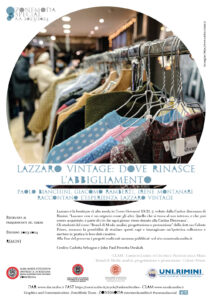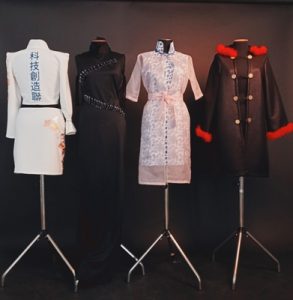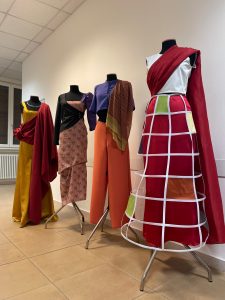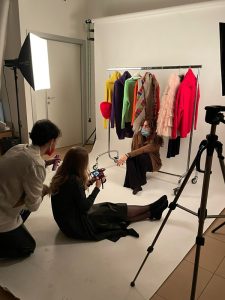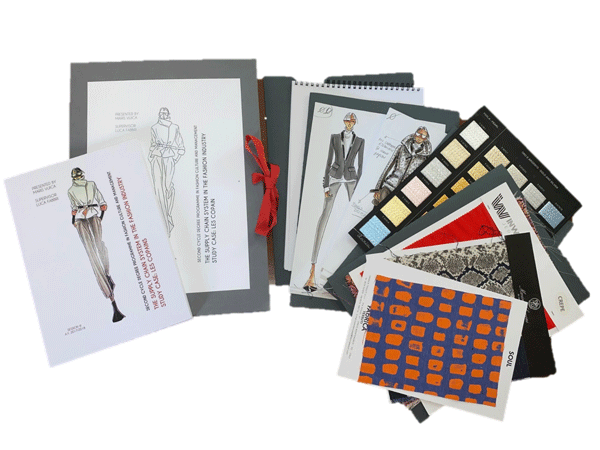
“THE SUPPLY CHAIN IN THE FASHION INDUSTRY. STUDY CASE: LES COPAINS” di Maris Vuica
VERSIONE ITALIANA
Progetto tesi FCM “THE SUPPLY CHAIN IN THE FASHION INDUSTRY. STUDY CASE: LES COPAINS” di Maris Vuica.
SUPPLY CHAIN STARTER PACK
Scrivere una tesi di laurea è da sempre un’esperienza significativa per uno studente, rappresenta innanzitutto il coronamento di un percorso di studi, ma soprattutto la possibilità di dimostrare i frutti del proprio lavoro, attraverso una forma di espressione personale.
Lo studente durante la sua fase di apprendimento è infatti come una spugna che assorbe e recepisce informazioni utili dai professori, per poi incamerarle ed elaborarle, dandone principalmente “dimostrazione” durante le prove di esame.
Al contrario, scrivere una tesi consiste nello scegliere un argomento di interesse personale in accordo con uno o più docenti, fare ricerca e trovare collegamenti, scrivere un elaborato ed infine presentarlo ad una commissione.
Si ribaltano quindi i ruoli, allo studente viene data l’opportunità di “restituire” ciò che ha imparato negli anni, proponendo una visione originale o rivisitata di un tema, “proponendo” ad un pubblico qualcosa di nuovo e interessante.
L’idea dietro questa tesi sta dunque nella risposta alla domanda: “Cosa posso portare di nuovo o rivisitato? Che cosa posso aggiungere?”
Durante l’università ho trovato utile e interessante ogni aspetto del mondo fashion, ma mi ha sempre affascinato sapere come un semplice figurino disegnato su un foglio di carta, potesse trasformarsi in un capo d’abbigliamento vero e proprio.
Parte di questa curiosità è stata placata dai corsi tenuti dal professore, e in seguito mio relatore, Luca Fabbri, in quanto riportano una fotografia accurata del funzionamento della filiera di moda e di tutti i micro settori che ne fanno parte.
Nonostante ciò, mi mancava la cosiddetta esperienza “sul campo”, per assistere in prima persona a tutte queste fasi, così, grazie alle iniziative promosse dell’università, ho potuto prendere parte ad un tirocinio d’eccellenza presso Les Copains.
Svolgere un tirocinio presso un’azienda storica e rinomata come questa, non solo ha consolidato il mio sapere teorico, ma mi ha “aperto gli occhi” su un aspetto fondamentale che spesso viene trascurato, ovvero il “know how”. Avere la possibilità di partecipare attivamente alle dinamiche di una realtà operante nell’abbigliamento, insegna che tanti aspetti non si imparano dai libri, al contrario, sono frutto di anni di esperienza e duro lavoro.
Quando ho pensato su cosa scrivere la mia tesi, mi sono chiesta che cosa potessi creare che unisse la curiosità al sapere didattico, così è nata “The supply chain system in the fashion industry. Study case: Les Copains”.
La struttura della tesi è stata pensata quindi come una sorta di “starter kit” o “manuale di istruzioni” formata da tre parti principali:
- Parte teorica
- Study case
- Esperienza tattile
La parte teorica ha come tema centrale la supply chain, quindi tutti quei processi necessari per passare da un’idea iniziale al prodotto finito e destinato alla vendita, che andranno a formare i veri e propri capitoli dell’elaborato. Questa parte fornisce le conoscenze base per comprendere gli step che mettono in collaborazione tutti i reparti interni ed esterni di una qualsiasi azienda del fashion.
Esempio:
- Chapter two: Launch of the collection
- Planning the presentation
- Choosing the format
Alla fine di ogni capitolo possiamo trovare uno “study case”, che consiste nella descrizione delle mansioni alle quali ho potuto assistere e partecipare in prima persona relative ad ogni capitolo o “fase operativa”.
Esempio:
- Study case: Showroom Presentation Les Copains Spring/Summer 2019 collection
Infine abbiamo l’esperienza tattile, che come suggerisce il nome, implica l’uso del tatto e più precisamente di tutti i sensi. Questa parte è strettamente legata al design delle componenti fisiche della tesi in quanto l’idea di uno “starter pack” è qualcosa di compatto che contenga e fornisca il necessario per comprendere/fare qualcosa.
Ho deciso quindi di creare una scatola su misura che contenesse il “manuale di istruzioni”, in questo caso la tesi stampata in formato libro, e una serie di carpette contenenti tutti i materiali e documenti utilizzati nelle fasi più importanti (campionature di tessuti e filati, figurini disegnati a mano, cartamodelli, lookbook, moodboard…).
Concludo dicendo che l’intento di questo progetto è di dare a chi non può fare un tirocinio o è semplicemente interessato ad approfondire le proprie conoscenze di questo ambito della moda, un’esperienza completa come se si trovasse davvero in un’azienda.
Mi ritengo molto fortunata per le opportunità che mi sono state offerte sia dall’università e dai suoi membri che dalle aziende che mi hanno ospitato e insegnato tutte quelle cose che non avrei imparato da sola, e spero con questa tesi di aver ispirato qualche altro studente che è curioso come lo sono stata io.
ENGLISH VERSION
FCM final dissertation project “THE SUPPLY CHAIN IN THE FASHION INDUSTRY. STUDY CASE: LES COPAINS” by Maris Vuica.
SUPPLY CHAIN STARTER PACK
Writing a degree thesis has always been a significant experience for a student, first it represents the culmination of a course of study, but above all the opportunity to reap the rewards of one’s work, through a form of personal expression.
During his learning phase, the student is in fact like a sponge that absorbs and receives useful information from the professors, then forfeits and elaborates them, mainly giving “demonstration” during the exam tests.
On the other hand, writing a thesis consists in choosing a topic of personal interest in agreement with one or more professors, doing research and finding connections, writing a paper and finally presenting it to a commission.
The roles are therefore reversed, the student is given the opportunity to “give back” what he has learned over the years, finding an original or revisited vision of a theme, “proposing” something new and interesting to an audience.
The idea behind this thesis therefore lies in the answer to the question: “What kind of new or revisited topic can I bring? What can I add? “
During university, I found every aspect of the fashion world useful and interesting, but it has always fascinated me to know how a simple sketch drawn on a sheet of paper could turn into a real piece of clothing.
Part of this curiosity was appeased by the courses held by the professor, and later my speaker, Luca Fabbri, as they report an accurate photograph of the functioning of the fashion supply chain and all the micro sectors that are part of it.
Despite this, I lacked the so-called “on the field” experience, to witness personally all these phases, so, thanks to the initiatives promoted by the University; I was able to take part in an internship at Les Copains.
Carrying out an internship in a historical and renowned company like this one, not only consolidated my theoretical knowledge, but “opened my eyes” on a fundamental aspect that is often overlooked, namely the “know how”.
Having the opportunity to actively participate in the dynamics of a reality operating in clothing, teaches that many aspects are not learned from books, on the contrary, they are the result of years of experience and hard work.
When I thought about what to write in my thesis, I asked myself what I could create that combined curiosity with didactic knowledge, so “The supply chain system in the fashion industry was born. Study case: Les Copains “was born.
The structure of this project is a sort of “starter kit” or “instruction manual” consisting of three main parts:
- Theoretical part
- Study case
- Tactile experience
The theoretical part has the supply chain as its central theme, therefore all those processes necessary to move from an initial idea to the finished product destined for sale, which will form the real chapters of the work. This part provides the basic knowledge to understand the steps that bring together all the internal and external departments of any fashion company.
Example:
Chapter two: Launch of the collection
Planning the presentation
Choosing the format
At the end of each chapter, we can find a “study case“, which consists of the description of the tasks I was able to attend and participate in first person related to each chapter or “operational phase”.
Example:
Study case: Showroom Presentation Les Copains Spring/Summer 2019 collection
Finally, we have the tactile experience, which as the name suggests, implies the use of touch and more precisely of all the senses. This part is closely linked to the design of the physical components of the thesis, as the idea ofa “starter pack” is something compact that contains and provides the necessary to understand / do something.
Therefore, I decided to create a tailor-made box that contained the “instruction manual”, in this case the thesis printed in book format, and a series of carpets containing all the materials and documents used in the most important phases (samples of fabrics and yarns, hand-drawn sketches, patterns, look-books, moodboards …).
I conclude by saying that the intent of this project is to give those who cannot do an internship or are simply interested in deepening their knowledge of this area of fashion, a complete experience as if they were really in a company.
I feel very lucky for the opportunities that have been offered to me, both by the university and its members and by the companies that have hosted and taught me all those things that I would not have learned on my own. With this thesis, I hope I have inspired some other student that is as curious as I have been.


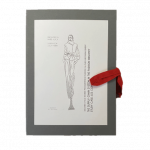
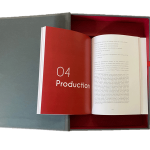
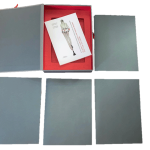
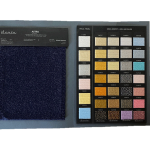
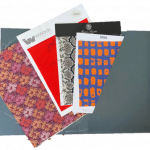
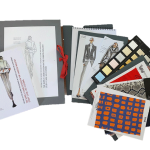
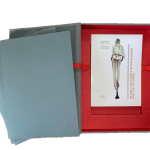
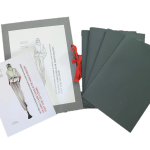
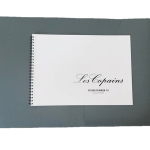
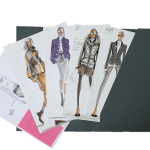
 Previous Post
Previous Post Next Post
Next Post